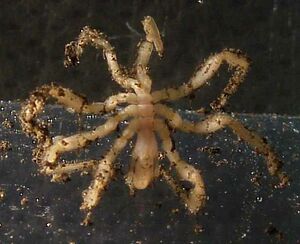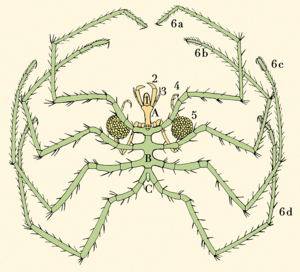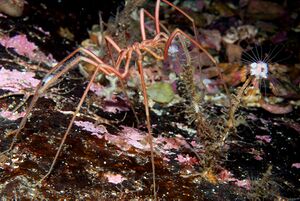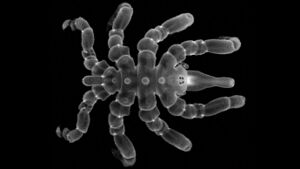عنكبوت البحر
| عناكب البحر | |
|---|---|

| |
| التصنيف العلمي | |
| أصنوفة غير معروفة (أصلحها): | الحياة |
| مملكة: | الحيوانية |
| Phylum: | مفصليات الأرجل |
| الشعيبة: | كلابيات القرون |
| الصف: | عنكبوت البحر لاتريل، 1810 |
| الرتبة: | عنكبوت البحر گرستايكر، 1863 |
| Type genus | |
| Pycnogonum برونيش، 1764
| |
| الفصائل | |
|
انظر النص. | |
| Synonyms | |
|
Arachnopoda دانا، 1853 | |
Sea spiders are marine arthropods of the order Pantopoda[1] (lit. ‘all feet’[2]), belonging to the class Pycnogonida,[3] hence they are also called pycnogonids ( /pɪkˈnɒɡənədz/;[4] named after Pycnogonum, the type genus;[5] with the suffix -id). They are cosmopolitan, found in oceans around the world. The over 1,300 known species have legs ranging from 1 mm (0.04 in) to over 70 cm (2.3 ft).[6] Most are toward the smaller end of this range in relatively shallow depths; however, they can grow to be quite large in Antarctic and deep waters.
Although "sea spiders" are not true spiders, or even arachnids, their traditional classification as chelicerates places them closer to true spiders than to other well-known arthropod groups, such as insects or crustaceans. This is in dispute, however, as genetic evidence suggests they may be the sister group to all other living arthropods.[7][8]
الوصف

Sea spiders have long legs in contrast to a small body size. The number of walking legs is usually eight (four pairs), but the family Pycnogonidae have species with five pairs, and the families Colossendeidae and Nymphonidae have species with both five and six pairs.[9] Seven species distributed among four genera (Decolopoda, Pentacolossendeis, Pentapycnon, and Pentanymphon) have five pairs, and two species in two genera (Dodecolopoda and Sexanymphon) have six pairs.[10] Pycnogonids do not require a traditional respiratory system. Instead, gasses are absorbed by the legs and transferred through the body by diffusion. A proboscis allows them to suck nutrients from soft-bodied invertebrates, and their digestive tract has diverticula extending into the legs.

Certain pycnogonids are so small that each of their very tiny muscles consists of a single cell, surrounded by connective tissue. The anterior region (cephalon) consists of the proboscis, which has fairly limited dorsoventral and lateral movement, the ocular tubercle with eyes, and up to four pairs of appendages. The first of these are the chelifores, followed by the palps , the ovigers, which are used for cleaning themselves and caring for eggs and young as well as courtship, and the first pair of walking legs. Nymphonidae is the only family where both the chelifores and the palps are functional. In the others the chelifores or palps, or both, are reduced or absent. In some families, also the ovigers can be reduced or missing in females, but are always present in males.[11] In those species that lack chelifores and palps, the proboscis is well developed and flexible, often equipped with numerous sensory bristles and strong rasping ridges around the mouth. The last segment includes the anus and tubercle, which projects dorsally.
In total, pycnogonids have four to six pairs of legs for walking. A cephalothorax and a much smaller unsegmented abdomen make up the extremely reduced body of the pycnogonid, which has up to two pairs of dorsally located simple eyes on its non-calcareous exoskeleton, though sometimes the eyes can be missing, especially among species living in the deep oceans. The abdomen does not have any appendages, and in most species it is reduced and almost vestigial. The organs of this chelicerate extend throughout many appendages because its body is too small to accommodate all of them alone.
The morphology of the sea spider creates an efficient surface area-to-volume ratio for respiration to occur through direct diffusion. Oxygen is absorbed by the legs and is transported via the hemolymph to the rest of the body.[12] The most recent research seems to indicate that waste leaves the body through the digestive tract or is lost during a moult. The small, long, thin pycnogonid heart beats vigorously at 90 to 180 beats per minute, creating substantial blood pressure. The beating of the sea spider heart drives circulation in the trunk and in the part of the legs closest to the trunk, but is not important for the circulation in the rest of the legs.[12] Hemolymph circulation in the legs is mostly driven by the peristaltic movement in the part of the gut that extends into every leg, a process called gut peristalsis.[12][13] These creatures possess an open circulatory system as well as a nervous system consisting of a brain which is connected to two ventral nerve cords, which in turn connect to specific nerves.
التكاثر والتطور
All pycnogonid species have separate sexes, except for one species that is hermaphroditic. Females possess a pair of ovaries, while males possess a pair of testes located dorsally in relation to the digestive tract. Reproduction involves external fertilisation after "a brief courtship"[بحاجة لمصدر]. Only males care for laid eggs and young.
The larva has a blind gut and the body consists of a head and its three pairs of cephalic appendages only: the chelifores, palps and ovigers. The abdomen and the thorax with its thoracic appendages develop later. One theory is that this reflects how a common ancestor of all arthropods evolved; starting its life as a small animal with a pair of appendages used for feeding and two pairs used for locomotion, while new segments and segmental appendages were gradually added as it was growing.
At least four types of larvae have been described: the typical protonymphon larva, the encysted larva, the atypical protonymphon larva, and the attaching larva. The typical protonymphon larva is most common, is free living and gradually turns into an adult. The encysted larva is a parasite that hatches from the egg and finds a host in the shape of a polyp colony where it burrows into and turns into a cyst, and will not leave the host before it has turned into a young juvenile.[14]
Little is known about the development of the atypical protonymphon larva. The adults are free living, while the larvae and the juveniles are living on or inside temporary hosts such as polychaetes and clams. When the attaching larva hatches it still looks like an embryo, and immediately attaches itself to the ovigerous legs of the father, where it will stay until it has turned into a small and young juvenile with two or three pairs of walking legs ready for a free-living existence.
إعادة تجديد أجسامها
في 23 يناير 2023 أفاد باحثون في مجلة Proceedings of the National Academy of Sciences، أن بعض الكائنات يمكنها تجديد أجزاء كاملة تقريبًا من نصفيها السفليين - بما في ذلك العضلات والأعضاء التناسلية وفتحة الشرج - أو الاستغناء عنها.[15]
القدرة على إعادة نمو أجزاء الجسم ليست شائعة جدًا، ولكن بعض الأنواع تمكنت من التخلص منها. يمكن لبعض رؤوس البزاقات البحرية أن تصنع جسمًا جديدًا تمامً. يمكن لعناكب البحر وبعض المفصليات الأخر- إعادة نمو أجزاء من أرجلها. لكن يعتقد الباحثون أن الأرجل الجديدة هي مدى قوة أي مفصليات الأرجل، ربما لأن مظهرها الخارجي الصلب يمنعها بطريقة ما من تجديد أجزاء أخرى من الجسم.
عن طريق حادث غير مقصود، اكتشف عالم الأحياء التطورية من جامعة ڤيينا جورج برنيس إن عناكب البحر قد تكون قادرة على التعامل مع إصلاحات أكثر تعقيدًا أيضًا. حدث ذلك عندما أصاب عن طريق الخطأ عينة صغيرة واحدة كان يعمل عليها في المختبر بالملقط. يقول برنيس: "لم تكن العينة ميتة، كانت تتحرك، لذا احتفظت بها". بعد عدة أشهر، كان لعنكبوت البحر ساق إضافية بدلاً من تلك الندبة، حسبما أفاد هو وعالم الأحياء التطوري جيرهارد شولتز من جامعة هومبولت في برلين عام 2016.
في الدراسة الجديدة، تعافى معظم العناكب الصغيرة التسعة عشر وأعادوا بناء العضلات المفقودة وأجزاء أخرى من النصف السفلي بعد البتر، على الرغم من أن التجدد لم يكن دائمًا مثاليًا. نما لبعض العناكب الصغيرة ستة أو سبعة أرجل بدلاً من ثمانية. لم ينجح أي من العناكب الأربعة البالغة في تجديد الأجزء المبتورة. قد يكون هذا بسبب أن البالغين لا يتخلصون من جلدهم أثناء نموهم، مما يشير إلى أن التجدد والانسلاخ مرتبطان بطريقة ما، كما يقول برنيس. كما أن اثنين من عناكب البحر الصغيرة لم يتجددا على الإطلاق. نجت الحيوانات بأربع أرجل فقط وبدون فتحة شرج. بدلاً من التبرز، كانت تخرج الفضلات من أفواههم. يقول برنيس إن الخطوة التالية هي معرفة ما إذا كانت مفصليات الأرجل الأخرى تتجدد أيضًا أكثر مما اعتقد العلماء، وكيف تقوم العناكب البحرية بذلك.
الانتشار وعلم البيئة
These animals live in many different parts of the world, from Australia, New Zealand, and the Pacific coast of the United States, to the Mediterranean Sea and the Caribbean Sea, to the north and south poles. They are most common in shallow waters, but can be found as deep as 7,000 metres (23,000 ft), and live in both marine and estuarine habitats. Pycnogonids are well camouflaged beneath the rocks and among the algae that are found along shorelines.
Sea spiders either walk along the bottom with their stilt-like legs or swim just above it using an umbrella pulsing motion.[16] Sea spiders are mostly carnivorous predators or scavengers that feed on cnidarians, sponges, polychaetes, and bryozoans. Although they can feed by inserting their proboscis into sea anemones, which are much larger, most sea anemones survive this ordeal, making the sea spider a parasite rather than a predator of anemones.
التصنيف
The class Pycnogonida comprises over 1,300 species, which are normally split into eighty-six genera. The correct taxonomy within the group is uncertain, and it appears that no agreed list of orders exists. All families are considered part of the single order Pantopoda.
Sea spiders have long been considered to belong to the Chelicerata, together with horseshoe crabs, and the Arachnida, which includes spiders, mites, ticks, scorpions, and harvestmen, among other, lesser-known orders.[17]
A competing theory proposes that pycnogonida belong to their own lineage, distinct from chelicerates, crustaceans, myriapods, or insects. This theory contends that the sea spider's chelifores, which are unique among extant arthropods, are not in any way homologous to the chelicerae in real chelicerates, as was previously supposed. Instead of developing from the deutocerebrum, they can be traced to the protocerebrum, the anterior part of the arthropod brain and found in the first head segment that in all other arthropods give rise to the eyes only. This is not found anywhere else among arthropods, except in some fossil forms like Anomalocaris, indicating that the Pycnogonida may be a sister group to all other living arthropods, the latter having evolved from some ancestor that had lost the protocerebral appendages. If this is confirmed, it would mean the sea spiders are the last surviving (and highly modified) members of an ancient stem group of arthropods that lived in Cambrian oceans.[18] However, a subsequent study using Hox gene expression patterns consistent with a developmental homology between chelicerates and chelifores, with chelifores innervated from a deuterocerebrum that has been rotated forwards; thus, the protocerebral Great Appendage clade does not include the Pycnogonida.[19][20][نشر ذاتي سطري?]
Recent work places the Pycnogonida outside the Arachnomorpha as basal Euarthropoda, or inside Chelicerata (based on the chelifore-chelicera putative homology).[21]
تصنيف المجموعات
According to the World Register of Marine Species, the order Pantopoda is subdivided as follows:[22]
- suborder Eupantopodida[23]
- including the following superfamilies:
- Ascorhynchoidea Pocock, 1904
- Colossendeidoidea Hoek, 1881
- Nymphonoidea Pocock, 1904
- Phoxichilidoidea Sars, 1891
- Pycnogonoidea Pocock, 1904
- Rhynchothoracoidea Fry, 1978
- suborder Stiripasterida Fry, 1978[24] including the following family:
- Austrodecidae Stock, 1954
- suborder incertae sedis,[25] including the following extinct genera:
- Flagellopantopus Poschmann & Dunlop, 2005 †
- Palaeothea Bergstrom, Sturmer & Winter, 1980 †
- family Pantopoda incertae sedis, including the following genera:
- Alcynous Costa, 1861 (nomen dubium)
- Foxichilus Costa, 1836 (nomen dubium)
- Oiceobathys Hesse, 1867 (nomen dubium)
- Oomerus Hesse, 1874 (nomen dubium)
- Paritoca Philippi, 1842 (nomen dubium)
- Pephredro Goodsir, 1842 (nomen dubium)
- Phanodemus Costa, 1836 (nomen dubium)
- Platychelus Costa, 1861 (nomen dubium)
This taxonomic classification replaces the older version in which Pantopoda is subdivided into families as follows:
- Ammotheidae
- Austrodecidae
- Callipallenidae
- Colossendeidae
- Endeididae
- Nymphonidae
- Pallenopsidae
- Phoxichilidiidae
- Pycnogonidae
- Rhynchothoracidae
السجل الأحفوري
Although the fossil record of pycnogonids is scant, it is clear that they once possessed a coelom, but it was later lost, and that the group is very old.[بحاجة لمصدر]
The earliest fossils are known from the Cambrian 'Orsten' of Sweden, the Silurian Coalbrookdale Formation of England and the Devonian Hunsrück Slate of Germany. Some of these specimens are significant in that they possess a longer 'trunk' behind the abdomen and in two fossils the body ends in a tail; something never seen in living sea spiders.
In 2013, the first fossil pycnogonid found within an Ordovician deposit was reported from William Lake in Manitoba.[26]
In 2007, remarkably well preserved fossils were exposed in fossil beds at La Voulte-sur-Rhône, south of Lyon in south-eastern France. Researchers from the University of Lyon discovered about 70 fossils from three distinct species in the 160-million-year-old Jurassic La Voulte Lagerstätte. The find will help fill in an enormous gap in the history of these creatures.[27]
المصادر
- ^ "Pycnogonida". World Register of Marine Species. Taxon details.
- ^ قالب:Merriam-Webster: "taxonomic synonym of Pycnogonida < New Latin, from pant- + -poda"
- ^ قالب:Merriam-Webster: "New Latin, from Pycnogonum [...] + -ida"
- ^ قالب:MW
- ^ "pycnogonid". The Free Dictionary.
From New Latin Pycnogonida, class name, from Pycnogonum, type genus.
- ^ "Sea spiders provide insights into Antarctic evolution" (Press release). Department of the Environment and Energy, Australian Antarctic Division. 22 July 2010. Archived from the original on 31 July 2018. Retrieved 27 December 2017.
- ^ Regier, Jerome C.; Shultz, Jeffrey W.; Zwick, Andreas; Hussey, April; Ball, Bernard; Wetzer, Regina; Martin, Joel W.; Cunningham, Clifford W. (2010). "Arthropod relationships revealed by phylogenomic analysis of nuclear protein-coding sequences". Nature. 463 (7284): 1079–83. Bibcode:2010Natur.463.1079R. doi:10.1038/nature08742. PMID 20147900. S2CID 4427443.
- ^ Sharma, P. P.; Kaluziak, S. T.; Perez-Porro, A.R.; Gonzalez, V. L.; Hormiga, G.; Wheeler, W. C.; Giribet, G. (2014). "Phylogenomic Interrogation of Arachnida Reveals Systemic Conflicts in Phylogenetic Signal". Molecular Biology and Evolution. 31 (11): 2963–84. doi:10.1093/molbev/msu235. PMID 25107551.
- ^ Ruppert, Edward E. (1994). Invertebrate Zoology (in English). Barnes, Robert D. (6th ed.). Fort Worth, TX: Saunders College Pub. ISBN 0-03-026668-8. OCLC 30544625.
{{cite book}}: CS1 maint: unrecognized language (link) - ^ Crooker, Allen (2008). "Sea Spiders (Pycnogonida)". In Capinera, John L. (ed.). Encyclopedia of Entomology (in الإنجليزية). Dordrecht, NL: Springer Netherlands. pp. 3321–3335. doi:10.1007/978-1-4020-6359-6_4098. ISBN 978-1-4020-6359-6.
- ^ Phylogenomic Resolution of Sea Spider Diversification through Integration of Multiple Data Classes
- ^ أ ب ت Woods, H. Arthur; Lane, Steven J.; Shishido, Caitlin; Tobalske, Bret W.; Arango, Claudia P.; Moran, Amy L. (2017-07-10). "Respiratory gut peristalsis by sea spiders". Current Biology (in الإنجليزية). 27 (13): R638–R639. doi:10.1016/j.cub.2017.05.062. ISSN 0960-9822. PMC 5344685. PMID 28238655.
- ^ Respiratory gut peristalsis by sea spiders - ScienceDirect
- ^ Bain, B. A. (2003). "Larval types and a summary of postembryonic development within the pycnogonids". Invertebrate Reproduction & Development. 43 (3): 193–222. doi:10.1080/07924259.2003.9652540. S2CID 84345599.
- ^ "Some young sea spiders can regrow their rear ends". sciencenews. 2023-01-23. Retrieved 2023-01-30.
- ^ McClain, Craig (August 14, 2006). "Sea Spiders". Deep Sea News Info. Archived from the original on 29 July 2007.
{{cite web}}:|archive-date=/|archive-url=timestamp mismatch; 9 يوليو 2007 suggested (help)[dead link] - ^ Margulis, Lynn; Schwartz, Karlene (1998). Five Kingdoms, An Illustrated Guide to the Phyla of Life on Earth (third ed.). W.H. Freeman and Company. ISBN 978-0-7167-3027-9.[صفحة مطلوبة]
- ^ Maxmen, Amy; Browne, William E.; Martindale, Mark Q.; Giribet, Gonzalo (2005). "Neuroanatomy of sea spiders implies an appendicular origin of the protocerebral segment". Nature. 437 (7062): 1144–8. Bibcode:2005Natur.437.1144M. doi:10.1038/nature03984. PMID 16237442. S2CID 4400419.
- ^ Jager, Muriel; Murienne, Jérôme; Clabaut, Céline; Deutsch, Jean; Guyader, Hervé Le; Manuel, Michaël (2006). "Homology of arthropod anterior appendages revealed by Hox gene expression in a sea spider". Nature. 441 (7092): 506–8. Bibcode:2006Natur.441..506J. doi:10.1038/nature04591. PMID 16724066. S2CID 4307398.
- ^ "Chelifores, chelicerae, and invertebrate evolution | ScienceBlogs". scienceblogs.com. Retrieved 2022-01-10.
- ^ Dunlop, J. A.; Arango, C. P. (2005). "Pycnogonid affinities: A review". Journal of Zoological Systematics and Evolutionary Research. 43: 8–21. CiteSeerX 10.1.1.714.8297. doi:10.1111/j.1439-0469.2004.00284.x.
- ^ "WoRMS - World Register of Marine Species - Pantopoda". marinespecies.org. Retrieved 2022-01-10.
- ^ "WoRMS - World Register of Marine Species - Eupantopodida". marinespecies.org. Retrieved 2022-01-10.
- ^ "WoRMS - World Register of Marine Species - Stiripasterida". marinespecies.org. Retrieved 2022-01-10.
- ^ "WoRMS - World Register of Marine Species -". marinespecies.org. Retrieved 2022-01-10.
- ^ Rudkin, Dave; Cuggy, Michael B.; Young, Graham A.; Thompson, Deborah P. (2013). "An Ordovician Pycnogonid (Sea Spider) with Serially Subdivided 'Head' Region". Journal of Paleontology. 87 (3): 395–405. doi:10.1666/12-057.1. S2CID 83924778. Retrieved 23 September 2017.
Here we report the first known occurrence of fossil pycnogonids from rocks of Ordovician age, bridging a 65 Myr gap between controversial late Cambrian larval forms and a single documented Silurian specimen. The new taxon, Palaeomarachne granulata n. gen. n. sp., from the Upper Ordovician (ca. 450 Ma) William Lake Konservat-Lagerstätte deposit in Manitoba, Canada, is also the first reported from Laurentia. It is the only record thus far of a fossil sea spider in rocks of demonstrably shallow marine origin.
- ^ "Fossil sea spiders thrill experts". BBC News. August 16, 2007.
وصلات خارجية
 Information related to Pycnogonida from Wikispecies.
Information related to Pycnogonida from Wikispecies. Media related to Pycnogonida at Wikimedia Commons
Media related to Pycnogonida at Wikimedia Commons Chisholm, Hugh, ed. (1911). . دائرة المعارف البريطانية (eleventh ed.). Cambridge University Press.
Chisholm, Hugh, ed. (1911). . دائرة المعارف البريطانية (eleventh ed.). Cambridge University Press. {{cite encyclopedia}}: Cite has empty unknown parameter:|coauthors=(help)- PycnoBase: World list of Pycnogonida
- Introduction to the Pycnogonida
- Images of Pycnogonida, and Pycnogonids in literature
- Bibliography (compiled by Franz Krapp)
- Articles containing لاتينية-language text
- CS1 errors: archive-url
- Articles with dead external links from January 2022
- مقالات بالمعرفة بحاجة لذكر رقم الصفحة بالمصدر from March 2015
- Articles containing ألمانية-language text
- Short description is different from Wikidata
- Automatic taxobox cleanup
- Articles with unsourced statements from December 2021
- All articles with self-published sources
- Articles with self-published sources from March 2015
- Articles with unsourced statements from January 2016
- مقالات المعرفة المحتوية على معلومات من دائرة المعارف البريطانية طبعة 1911
- Pycnogonids
- Extant Cambrian first appearances
- Taxa named by Carl Eduard Adolph Gerstaecker

